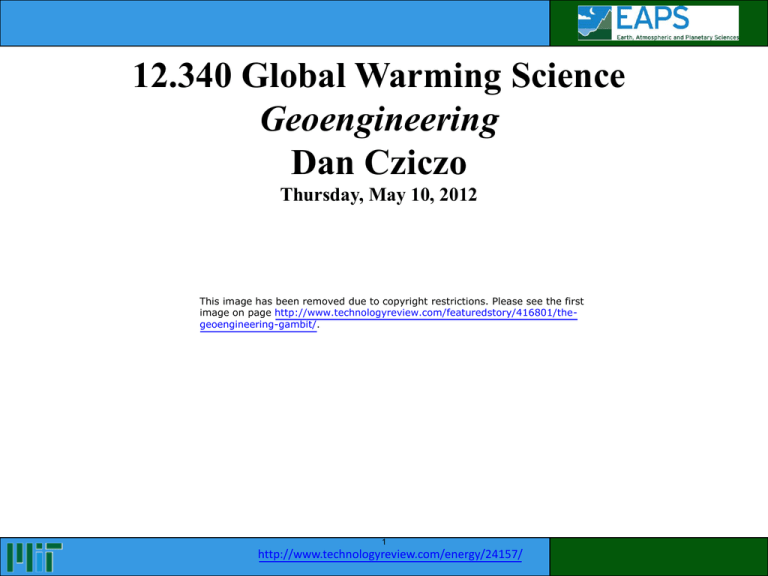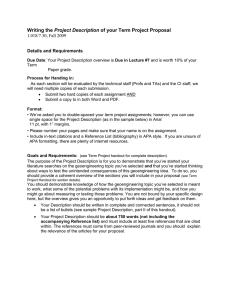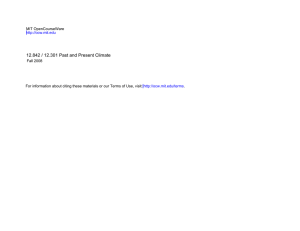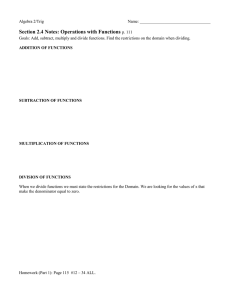12.340 Global Warming Science Dan Cziczo Geoengineering Thursday, May 10, 2012
advertisement

12.340 Global Warming Science Geoengineering Dan Cziczo Thursday, May 10, 2012 This image has been removed due to copyright restrictions. Please see the first image on page http://www.technologyreview.com/featuredstory/416801/thegeoengineering-gambit/. 1 http://www.technologyreview.com/energy/24157/ ONLINE SUBJECT EVALUATIONS ARE NOW OPEN http://web.mit.edu/subjectevaluation • You have until Monday, May 21 at 9 AM • Please evaluate all subjects in your list • Write comments Your feedback is read and valued! 2 “Geoengineering” History Weather modification - The changing of natural weather phenomena by technical means; for example through the microscale of condensation and freezing nuclei. Terraforming - transform (a planet) so as to resemble the earth, especially so that it can support human life (Oxford Dictionaries, normally attributed to Jack Williamson "Collision Orbit” (1942) although many similarities to H.G. Wells “The War of the Worlds” (1898)). This image has been removed due to copyright restrictions. Please see the first image on page http://www.erbzine.com/mag14/marsterr.jpg . Geoengineering - the deliberate large-scale manipulation of an environmental process that affects the earth’s climate, in an attempt to counteract the effects of global warming (Oxford Dictionaries). Generally attributed to Paul Crutzen (2006) but several earlier works. http://www.erbzine.com/mag14/marsterr.jpg 3 Weather Modification History Initial attempts at weather modification were of limited success… This image has been removed due to copyright restrictions. Please see the second image on http://www.desertusa.com/mag07/jan/imagesinstone.html. 4 Lest you think this was a long time ago… Hail Cannon (1901) This image has been removed due to copyright restrictions. Please see the first image on page http://www.sacreddestinations.com/france/anzy-leduc-church. This image has been removed due to copyright restrictions. Please see the first image on page http://www.absurdintellectual.com/2009/06/22/allhail-the-hail-cannons/. Cloud Seeding 5 Lest you think this was a long time ago… This image has been removed due to copyright restrictions. Please see the image on page http://www.hailcannon.com/pictures.html. 6 The ‘Modern’ Age of Weather Mod Mid-1940’s. Generally considered to have grown out of the WWII contrail research. The pioneers : Vincent Shaefer, Irving Langmuir and Bernie Vonnegut at GE. Showed that particles with water-ice structure could effectively nucleate ice at temperature near 0° C. PbO + 0.1m NH4 I 0.1m NH4 I PbO PbI2 Freezing nuclei per gram PbO 103 PbO + 0.01m NH4 I 105 102 104 101 103 100 102 Freezing nuclei per cm3 106 10-1 0 -5 -10 -15 -20 -25 -30 Temperature (C) Freezing nucleus activity of the preparations as a function of temperature. Image by MIT OpenCourseWare. This image (published on the Journal of Meteorology by the American Meteorological Society) is copyright © AMS and used with permission. 7 This image has been removed due to copyright restrictions. Please see the image on page http://www.nap.edu/catalog.php?record_id=10829. National Academy of Science, 2003 : Last comprehensive report on weather modification. 8 The ‘Modern’ Age of Weather Mod Early “demonstrations” with clouds were mixed: increased glaciation was observed but little or no enhanced precipitations (clouds contained too little water). “Need for impartial assessment” recognized as early as 1957. “Double blind” studies suggested 1957, 1963 (“…it has not been demonstrated that precipitation … can be increased significantly by seeding…”), 1973 (“ice-nuclei seeding can sometimes lead to more precipitation, can sometimes lead to less precipitation, and at other times … have no effect…”), 2003 (“…our Committee finds little reason to differ from these findings…”). Point : Theory itself does not show if a technique works when multiple steps are involved (in this case initiation, not growth and precipitation). Further, the scale of the experiment (lab versus isolated cloud versus system) often leads to different results. 9 “By far the preferred way to resolve the policy makers’ dilemma is to lower the emissions of the greenhouse gases.” “Therefore, although by far not the best solution, the usefulness of artificially enhancing earth’s albedo and thereby cooling climate by adding sunlight reflecting aerosol in the stratosphere (Budyko, 1977; NAS, 1992) might again be explored and debated…” “Finally, I repeat: the very best would be if emissions of the greenhouse gases could be reduced so much that the stratospheric sulfur release experiment would not need to take place. Currently, this looks like a pious wish.” 10 Early References… Budyko, M. I.: 1977, ‘Climatic Changes, American Geophysical Society’, Washington, D.C., 244 pp. Bodansky, D.: 1996, ‘May we engineer the climate?’, Clim. Change 33, 309–321. Dickinson, R. E.: 1996, ‘Climate Engineering. A review of aerosol approaches to changing the global energy balance’, Clim. Change 33, 279–290. Jamieson, D.: 1996, ‘Ethics and intentional climate change’, Clim. Change 33, 323 336. Schneider, S. H.: 1996, ‘Geoengineering: Could-or-Should-we do it’, Clim. Change 33, 291–302. Keith, D. W.: 2000, ‘Geoengineering the climate: History and prospect’, Annu. Rev. Energy Environ. 25, 245–284. National Academy of Sciences (NAS): 1992, Policy Implications of Greenhouse Warming: Mitigation, Adaptation, and the Science Base, Panel on Policy Implications of Greenhouse Warming, Committee on Science, Engineering, and Public Policy, National Academy Press, Washington DC, 918 pp. 11 …But Not The Earliest “The climatic changes that may be produced by the increased CO2 content could be deleterious from the point of view of human beings. The possibilities of deliberately bringing about countervailing climatic changes therefore need to be thoroughly explored. A change in the radiation balance in the opposite direction to that which might result from the increase of atmospheric CO2 could be produced by raising the albedo, or reflectivity, of the earth. Such a change in albedo could be brought about, for example, by spreading very small reflecting particles over large oceanic areas.” 12 This image has been removed due to copyright restrictions. Please see the image on page http://www.nextnature.net/2010/02/nine-geoengineeringstrategies/. Reduction of Solar Radiation/ Higher Albedo Carbon Capture 13 Source: New Scientist Albedo Increase / Solar Mitigation Boundary to space (1 - α)lsolar lup, atmosphere 4 This image has been removed due to copyright restrictions. Please see the image on page https://commons.wikimedia. org/wiki/File:Albedo-e_hg.svg. ldown, atmosphere lup, ground Earth Image by MIT OpenCourseWare. 14 Archer, 2007 Simple Albedo Increase Necessary square footage >> available square footage Image courtesy of nyc.gov. Courtesy Jimmy Gasore, Haider et al., 1997 15 Nature’s Examples : Direct Effect This image has been removed due to copyright restrictions. Please see Figure 6 on page http://onlinelibrary.wiley.com/doi/10.1029/2009JD0 12105/full. Murphy et al. JGR 2009 16 Climate Model Response Climate Change 2007: The Physical Science Basis. Working Group I Contribution to the Fourth Assessment Report of the Intergovernmental Panel on Climate Change, Figure 9.5. Cambridge University Press. Used with permission. 17 IPCC 2007 Models Natural Version of the Direct Effect Method Image courtesy of USGS. Robock, 1998 Image courtesy of NASA. Pinatubo : ~15 Tg SO2 into the stratosphere. 18 540 520 500 W/m2 480 460 440 420 400 El Chichon Mt Pinatubo 380 360 340 0 1978 1978 1980 1982 1984 1986 1988 1990 1982 1992 1994 1996 1998 1991 Image by MIT OpenCourseWare. Global temperatures dropped by 0.4-0.6°C after Pinatubo. Particle layer persisted for 3 years (e-folding ~1 year). IPCC, 2001 Houghton, J. T.,Y. Ding, D. J. Griggs, M. Noguer, P. J. van der Linden, X. Dai, K. Maskell, and C. A. Johnson (eds.): Climate Change 2001: The Scientific Basis. Contribution of Working Group I to the Third Assessment Report of the Intergovernmental Panel on Climate Change. Cambridge, UK: Cambridge University Press. Used with permission. 19 The Direct Effect Method Say we want to “offset” current ~0.75° C warming. Pinatubo was ~15 Tg SO2 injection. This image has been removed due to copyright restrictions. Please see the third image on page http://www.technology review.com/energy/24157/. Some variation of initial injection of ~20 Tg sulfuric acid and then an increasing yearly amount of 10+ Tg Aircraft, balloon and other ‘designs’ (25km tethered hose) proposed. 20 http://www.technologyreview.com/energy/24157/ The Indirect Effect Method Climate Change 2007: The Physical Science Basis. Working Group I Contribution to the Fourth Assessment Report of the Intergovernmental Panel on Climate Change, Figure 2.10. Cambridge University Press. Used with permission. 21 IPCC 2007 Anthropogenic Example This image has been removed due to copyright restrictions. Please see Figure 6 on page http://onlinelibrary.wiley.com/doi/10.1029/2009JD012105/full. Murphy et al. JGR 2009 22 from D. Rosenfeld Image courtesy of Danniel Rosenfeld. Used with permission. Image courtesy of NASA. 23 NASA, January 27, 2003 Atlantic, France, Spain US Navy Image courtesy of US Navy. Unpublished results: use of particle production in Marine Boundary Layer (MBL) with cloud formation ~1 in 10 times This image has been removed due to copyright restrictions. Please see the image on page http://physicsworld.com/cws /article/news/35693/1/cloud. Stephen Salter’s design 24 Risk vs. Reward Reward 1. 2. 3. 4. 5. 6. Cool planet Reduce or reverse ice loss Reduce or reverse sea level rise Increase plant productivity Nice sunsets Better precipitation control? Risk 1. Regional droughts 2. Continued ocean acidification 3. Ozone depletion 4. Diffuse radiation effect on plants 5. Acid deposition 6. Cirrus effects 7. White skies 8. Lower solar power margins 9. Environmental side effects 10. Cannot stop effects quickly (1-3 years or more) 11. Rapid warming if stopped (all effects back in 1-3 years) 12. Human error 13. Undermining mitigation efforts 14. Cost 15. Who controls? Commercialization 16. Military use 17. Whose hand on the thermostat? 18. Conflict with treaties 19. “Unknown unknowns” What would you propose as a method? 1. Model all results first? 2. Small scale tests? For direct effect method how do you do this? 3. Are there effects that can’t be accepted? 25 Robock 2008 A Mauna Loa Solar Radiation (Wm-1) 500 400 Total Direct 300 Diffuse 200 100 0 1990 1992 1994 1996 1998 As with the example of cheaper natural gas, the “stop gap” makes a possible “long term solution” much less likely Year Sunlight measured at Mauna Loa. The reduction in direct sunlight and increase in diffuse sunlight following the eruption of Mt. Pinatubo in 1991 are readily apparent. The reduction in total sunlight was much smaller. 100 700 600 80 40 500 Annual solar output 60 400 300 Summer on-peak capacity 200 20 SEGS Gross Solar Output (CWh) SEGS On-Peak Summer Capacity (%) B Effect of Stratospheric Aerosols on Direct Sunlight and Implications for Concentrating Solar Power 100 0 1990 1992 1994 1996 1998 DANIEL, M. MURPHY* Year Earth system research laboratory, Chemical sciences division, National oceanic and atmospheric administration, 325 Broadway, Boulder, Colorado 80305 Output of the solar electric generating systems (SEGS) solar thermal power plants in California (data are from ref 9). The SEGS plants had significant reductions in on-peak capacity and total output following the eruption of Mt. Pinatubo. Image by MIT OpenCourseWare. 26 Image by MIT OpenCourseWare. Summer sea ice goes away with a doubling of CO2 This image has been removed due to copyright restrictions. Please see Figure 2 in http://iopscience.iop.org/17489326/4/4/045112/fulltext/. Ice returns with geoengineering (but not homogeneously) It is possible to overdo the effect Rasch et al., 2009 27 Precipitation change from stratospheric sulfate Model #1 (Hadley) This image has been removed due to copyright restrictions. Please see Figure 4 in http://www.atmos-chem-phys.net/10/5999/2010/acp-10-5999-2010.pdf. Model #2 (NASA GISS) 28 Jones et al., 2010 This image has been removed due to copyright restrictions. Please see Figure 4 in http://onlinelibrary.wiley.com/doi/10.1029/2008JD011450/full. Precipitation change from marine cloud seeding 29 Jones et al., 2009 The Ozone Effect Image courtesy of NOAA. 30 The Ozone Effect Image courtesy of NOAA. This image (published on the Journal of Atmospheric Sciences by the American Meteorological Society) is copyright © AMS and used with permission. 31 This image has been removed due to copyright restrictions. Please see Figure 8 in http://climate.envsci.rutgers.edu/pdf/RaschPhilTrans.pdf. Baseline With Geoengineering Ethics in research : when do you decide to stop researching a topic because the result is too negative? When does “we should know more about it in case we try it” conflict with “this is not a good idea”? 32 Rasch et al., 2008 This image has been removed due to copyright restrictions. Please see the image on page http://en.wikipedia.org/wiki/File:ENMOD_Participation.svg. “Convention on the Prohibition of Military or Any Other Hostile Use of Environmental Modification Techniques” (ENMOD) prohibits the use of the environment as a weapon. A result of opposition to Agent Orange and weather modification during Vietnam Adopted by the UN General Assembly on 10 December 1976 and opened for signature on 18 May 1977, ENMOD entered into force when Laos, the twentieth State Party, deposited its instrument of ratification on 5 October 1978. 33 Map : wikipedia For you to consider 1. Have we shown that the “cure” is better than the “disease”? 2. Is this really the same as what we’ve already done (“inadvertent” climate modification)? 3. If this is a “last resort” are we certain it is going to work? This image has been removed due to copyright restrictions. Please see the second image on page http://www.technologyreview.com/featuredstory/416801/the-geoengineering-gambit/. 34 http://www.technologyreview.com/energy/24157/ MIT OpenCourseWare http://ocw.mit.edu 12.340 Global Warming Science Spring 2012 For information about citing these materials or our Terms of Use, visit: http://ocw.mit.edu/terms.



